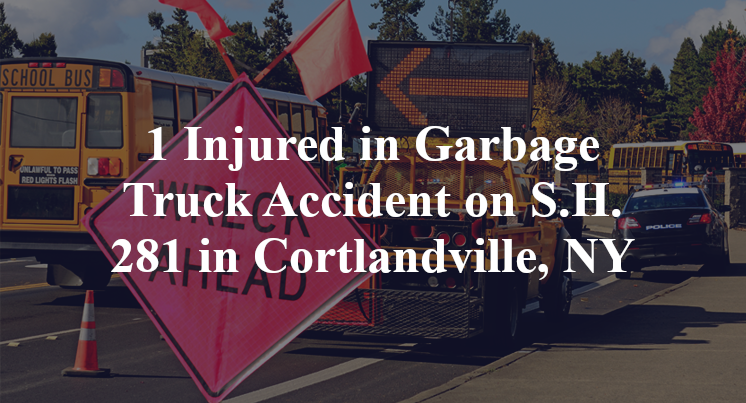1 Injured in Garbage Truck Accident on S.H. 281 in Cortlandville, NY
Cortlandville, NY — April 16, 2025, one person was injured in a garbage truck accident at approximately 8:45 a.m. along State Highway 281 (West Road).
According to authorities, the accident took place on West Road in the vicinity of the Lankler Driver intersection.

The cause of the accident remains unclear. Officials indicate that, for unknown reasons, a collision took place between the rear-end of a garbage truck and the front-end of a passenger vehicle. The man who had been behind the wheel of the passenger vehicle reportedly became entrapped in the wreckage and had to be extricated by emergency personnel. Once freed from the aftermath, the victim was transported to a local medical facility by EMS in order to receive necessary treatment for non-life-threatening injuries incurred over the course of the accident. Additional details pertaining to this incident—including the identity of the victim—are not available at this point in time. The investigation is currently ongoing.
Commentary by Attorney Michael Grossman
In my experience, rear-end collisions involving garbage trucks raise a unique set of legal and safety questions—especially when the smaller vehicle ends up with a driver trapped inside. While these trucks perform essential work, they also operate in a way that places added responsibility on the companies and drivers behind them. Frequent stops, wide turns, and time spent partially or fully in active lanes make them inherently more hazardous if not handled carefully.
One of the first things that needs to be established in a crash like this is whether the garbage truck was moving at the time of impact, or stopped for collection. Was it properly marked with hazard lights or reflective safety panels? Was the stop made in a safe location with enough time and space for approaching drivers to react? I’ve handled cases where garbage trucks were stopped just around a curve or over a hill, giving other drivers no meaningful chance to avoid a collision—even if they were paying full attention.
It’s also important to consider whether this was a sudden stop or part of a routine route. If the truck operator failed to signal their intent or stopped abruptly without checking for traffic behind them, that could shift some or all of the responsibility. These are large, slow-moving vehicles with limited rear visibility, and commercial drivers are trained to account for that with extra care and awareness.
And if the truck was being operated under a private waste collection company or municipal contract, the organization that owns and manages the vehicle also needs to be part of the conversation. Was the driver trained to operate in active traffic safely? Was the vehicle equipped with the proper lighting and warning systems? Was there a spotter or other support in place, depending on the location of the stop? These details matter—because they often reveal whether this incident was a one-off mistake or the result of a broader pattern of inadequate preparation.
From where I sit, a crash that leaves someone trapped in a vehicle after rear-ending a garbage truck isn’t something that should be taken at face value. It’s not just about who struck whom—it’s about whether the situation was set up in a way that gave everyone involved a reasonable opportunity to avoid the wreck. That’s why a full investigation is essential—not just to determine fault, but to ensure that the conditions that led to the crash are fully understood and addressed. Only then can the right parties be held accountable and those affected receive the clarity and closure they deserve.

“These are essential reads for anyone dealing with the aftermath of a truck wreck”– Attorney Cory Carlson